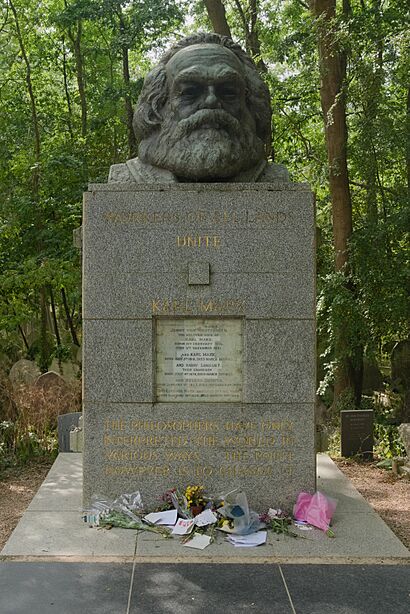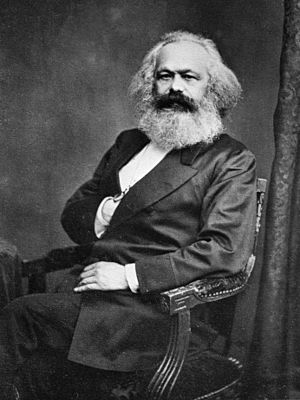Tomb of Karl Marx facts for kids
Quick facts for kids Tomb of Karl Marx |
|
|---|---|

Tomb of Karl Marx
|
|
| Artist | Laurence Bradshaw |
| Completion date | 1956 |
| Type | Sculpture |
| Medium | Bronze |
| Subject | Karl Marx |
| Dimensions | 3.7 m (12 ft) |
| Location | Highgate Cemetery London, N6 |
| 51°33′58″N 0°08′38″W / 51.5662°N 0.1439°W | |
|
Listed Building – Grade I
|
|
| Official name | Tomb of Karl Marx and family |
| Designated | 14 May 1974 |
| Reference no. | 1378872 |
The Tomb of Karl Marx is a famous memorial in Highgate Cemetery in North London, England. It marks the burial place of Karl Marx, his wife Jenny von Westphalen, and other family members. Marx was an important thinker and writer. His ideas are known as Marxism.
The family was first buried in a different spot. In 1954, their bodies were moved to the current location. The tomb was designed by Laurence Bradshaw. It was officially opened in 1956. The Communist Party of Great Britain paid for the memorial.
The tomb has a large bust (a sculpture of a head and shoulders) of Marx. It is made of bronze and sits on a marble base. On the front of the base are famous quotes from Marx's writings. One quote says, "Workers of all lands unite". This is from his book, The Communist Manifesto. The tomb is a special place for people who follow Marx's ideas. It has also been damaged by people who disagreed with him. It was bombed twice in the 1970s. The tomb is a Grade I listed structure. This means it is a very important historical building.
Karl Marx's Life and Burial
Karl Marx moved to London in June 1849. He was a political exile, meaning he had to leave his home country because of his political beliefs. He lived in different parts of London. From 1875 until his death, he lived in Belsize Park. During this time, Marx wrote some of his most important books. These include The Eighteenth Brumaire of Louis Napoleon and Das Kapital.
Marx often struggled with money while living in London. His friend and helper, Friedrich Engels, supported him a lot. Marx died on March 14, 1883. He had problems with his lungs. He was buried a few days later at Highgate Cemetery. This was the same grave where his wife had been buried a year and a half earlier. Engels gave a speech at the funeral.
About 13 people attended Marx's funeral. These included Engels, Marx's daughter Eleanor Marx, and other friends. Some newspapers at the time said 25 to 30 people were there. One newspaper noted that his death was not announced right away. This meant many friends did not know about the funeral until it was too late.
Creating the Tomb
In 1954, a group called the Marx Memorial Committee wanted to move Marx's grave. They got permission to move the bodies of Marx, his wife, other family members, and their housekeeper Helene Demuth. The bodies were moved to a new spot in the cemetery. This new spot was about 100 yards from the original graves. The move happened at night on November 26 and 27, 1954.
Moving the bodies was the first step to building the new tomb. The tomb was designed by Laurence Bradshaw. He was an artist and sculptor. He was also a member of the Communist Party. The Communist Party of Great Britain paid for the tomb. The tomb was officially opened on March 15, 1956. Harry Pollitt, the leader of the Communist Party, led the ceremony.
Since it was built, the tomb has become a special place for people who follow Marx's ideas. Some famous people are buried near Marx's tomb. These include Yusuf Dadoo, who fought against unfair laws in South Africa, and Claudia Jones, who started the Notting Hill Carnival.
The Marx Grave Trust owns the tomb. The Highgate Cemetery charges a fee to enter the cemetery. This money helps pay for the upkeep of the cemetery. Marx's grave is one of the most visited spots in Highgate Cemetery. It is known as "one of the most recognisable graves in the world."
Tomb Design and Features
Laurence Bradshaw designed the tomb. He said his goal was to create a monument not just for a person, but for a "great mind and a great philosopher." The tomb has a large bronze bust of Marx. This bust shows his head and shoulders. It sits on a marble base.
Bradshaw chose all the words written on the tomb. He also designed how the words looked. On the front of the memorial, there are two important quotes. One is the famous line from "The Communist Manifesto": "Workers of all lands unite". The other quote is from Marx's "Theses on Feuerbach": "The philosophers have only interpreted the world in various ways • the point however is to change it".
The sides of the memorial have three parts sticking out. The top two parts hold sculpted wreaths. A middle section lists the birth and death dates. It includes dates for Marx, his wife, their daughter Eleanor Marx, their grandson Harry Longuet, and their housekeeper Helene Demuth.
The base of the tomb is made of granite. Bradshaw wanted the bust to show Marx's "dynamic force of his intellect." He also wanted it to be at eye-level, not too high up. The tomb was listed as a historic building in 1974. In 1999, it was given the highest listing, Grade I.
Images for kids






